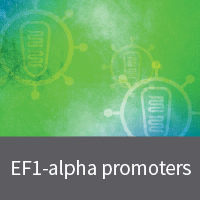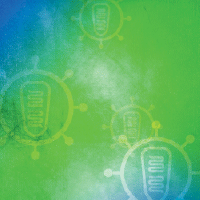631990
pLVX-EF1alpha-DsRed-Monomer-N1 Vector
10 ug
Inquire for Quotation
*
pLVX-EF1α-DsRed-Monomer-N1 is a lentiviral expression vector that can be used to generate high-titer lentivirus for transducing virtually any dividing or nondividing mammalian cell type, including primary and stem cells. The vector allows a gene-of-interest to be fused to the N-terminus of the fluorescent protein DsRed-Monomer. Expression of the fusion is driven by the human elongation factor 1 alpha (EF1α) promoter, which continues to be constitutively active even after stable integration of the vector into the host cell genome. Stable expression of the fusion allows the monitoring of a variety of cellular processes (such as differentiation in primary or stem cells), without the transgene silencing associated with CMV promoters. In addition, the vector allows efficient flow cytometric detection of stably or transiently transfected mammalian cells expressing DsRed-Monomer fusions, without time-consuming drug and clonal selection.
Notice to purchaser
Our products are to be used for Research Use Only . They may not be used for any other purpose, including, but not limited to, use in humans, therapeutic or diagnostic use, or commercial use of any kind. Our products may not be transferred to third parties, resold, modified for resale, or used to manufacture commercial products or to provide a service to third parties without our prior written approval.
631989
pLVX-EF1alpha-DsRed-Monomer-C1 Vector
10 ug
Inquire for Quotation
*
pLVX-EF1α-DsRed-Monomer-C1 is a lentiviral expression vector that can be used to generate high-titer lentivirus for transducing virtually any dividing or nondividing mammalian cell type, including primary and stem cells. The vector allows a gene-of-interest to be fused to the C-terminus of the fluorescent protein DsRed-Monomer. Expression of the fusion is driven by the human elongation factor 1 alpha (EF1α) promoter, which continues to be constitutively active even after stable integration of the vector into the host cell genome. Stable expression of the fusion allows the monitoring of a variety of cellular processes (such as differentiation in primary or stem cells) without the transgene silencing associated with CMV promoters. In addition, the vector allows efficient flow cytometric detection of stably or transiently transfected mammalian cells expressing DsRed-Monomer fusions, without time-consuming drug and clonal selection.
Notice to purchaser
Our products are to be used for Research Use Only . They may not be used for any other purpose, including, but not limited to, use in humans, therapeutic or diagnostic use, or commercial use of any kind. Our products may not be transferred to third parties, resold, modified for resale, or used to manufacture commercial products or to provide a service to third parties without our prior written approval.
631987
pLVX-EF1alpha-IRES-mCherry Vector
10 ug
Inquire for Quotation
*
pLVX-EF1α-IRES-mCherry is a bicistronic lentiviral expression vector that can be used to generate high-titer lentivirus for transducing virtually any dividing or nondividing mammalian cell type, including primary and stem cells. The vector contains an internal ribosomal entry site (IRES) that allows a gene-of-interest and the red fluorescent protein mCherry to be simultaneously coexpressed from a single mRNA transcript. Expression of the transcript is driven by the constitutively active human elongation factor 1 alpha (EF1α) promoter.
Notice to purchaser
Our products are to be used for Research Use Only . They may not be used for any other purpose, including, but not limited to, use in humans, therapeutic or diagnostic use, or commercial use of any kind. Our products may not be transferred to third parties, resold, modified for resale, or used to manufacture commercial products or to provide a service to third parties without our prior written approval.
631986
pLVX-EF1alpha-mCherry-N1 Vector
10 ug
Inquire for Quotation
*
pLVX-EF1α-mCherry-N1 is a lentiviral expression vector that can be used to generate high-titer lentivirus for transducing virtually any dividing or nondividing mammalian cell type, including primary and stem cells. The vector allows a gene-of-interest to be fused to the N-terminus of the red fluorescent protein mCherry. Expression of the fusion is driven by the human elongation factor 1 alpha (EF1α) promoter, which continues to be constitutively active even after stable integration of the vector into the host cell genome. Stable expression of the fusion allows the monitoring of a variety of cellular processes (such as differentiation in primary or stem cells) without the transgene silencing associated with CMV promoters. In addition, the vector allows efficient flow cytometric detection of stably or transiently transfected mammalian cells expressing mCherry fusions, without time-consuming drug and clonal selection.
Notice to purchaser
Our products are to be used for Research Use Only . They may not be used for any other purpose, including, but not limited to, use in humans, therapeutic or diagnostic use, or commercial use of any kind. Our products may not be transferred to third parties, resold, modified for resale, or used to manufacture commercial products or to provide a service to third parties without our prior written approval.
631985
pLVX-EF1alpha-mCherry-C1 Vector
10 ug
Inquire for Quotation
*
pLVX-EF1α-mCherry-C1 is a lentiviral expression vector that can be used to generate high-titer lentivirus for transducing virtually any dividing or nondividing mammalian cell type, including primary and stem cells. The vector allows a gene-of-interest to be fused to the C-terminus of the red fluorescent protein mCherry. Expression of the fusion is driven by the human elongation factor 1 alpha (EF1α) promoter, which continues to be constitutively active even after stable integration of the vector into the host cell genome. Stable expression of the fusion allows the monitoring of a variety of cellular processes (such as differentiation in primary or stem cells) without the transgene silencing associated with CMV promoters. In addition, the vector allows efficient flow cytometric detection of stably or transiently transfected mammalian cells expressing mCherry fusions, without time-consuming drug and clonal selection.
Notice to purchaser
Our products are to be used for Research Use Only . They may not be used for any other purpose, including, but not limited to, use in humans, therapeutic or diagnostic use, or commercial use of any kind. Our products may not be transferred to third parties, resold, modified for resale, or used to manufacture commercial products or to provide a service to third parties without our prior written approval.
631984
pLVX-EF1alpha-AcGFP1-C1 Vector
10 ug
Inquire for Quotation
*
pLVX-EF1α-AcGFP1-C1 is a lentiviral expression vector that can be used to generate high-titer lentivirus for transducing virtually any dividing or nondividing mammalian cell type, including primary and stem cells. The vector allows a gene-of-interest to be fused to the C-terminus of the green fluorescent protein AcGFP1. Expression of the fusion is driven by the human elongation factor 1 alpha (EF1α) promoter, which continues to be constitutively active even after stable integration of the vector into the host cell genome. Stable expression of the fusion allows the monitoring of a variety of cellular processes (such as differentiation in primary or stem cells) without the transgene silencing associated with CMV promoters. In addition, the vector allows efficient flow cytometric detection of stably or transiently transfected mammalian cells expressing AcGFP1 fusions, without time-consuming drug and clonal selection.
Notice to purchaser
Our products are to be used for Research Use Only . They may not be used for any other purpose, including, but not limited to, use in humans, therapeutic or diagnostic use, or commercial use of any kind. Our products may not be transferred to third parties, resold, modified for resale, or used to manufacture commercial products or to provide a service to third parties without our prior written approval.
631983
pLVX-EF1alpha-AcGFP1-N1 Vector
10 ug
Inquire for Quotation
*
pLVX-EF1α-AcGFP1-N1 is a lentiviral expression vector that can be used to generate high-titer lentivirus for transducing virtually any dividing or nondividing mammalian cell type, including primary and stem cells. The vector allows a gene-of-interest to be fused to the N-terminus of the green fluorescent protein AcGFP1. Expression of the fusion is driven by the human elongation factor 1 alpha (EF1α) promoter, which continues to be constitutively active even after stable integration of the vector into the host cell genome. Stable expression of the fusion allows the monitoring of a variety of cellular processes (such as differentiation in primary or stem cells) without the transgene silencing associated with CMV promoters. In addition, the vector allows efficient flow cytometric detection of stably or transiently transfected mammalian cells expressing AcGFP1 fusions, without time-consuming drug and clonal selection.
Notice to purchaser
Our products are to be used for Research Use Only . They may not be used for any other purpose, including, but not limited to, use in humans, therapeutic or diagnostic use, or commercial use of any kind. Our products may not be transferred to third parties, resold, modified for resale, or used to manufacture commercial products or to provide a service to third parties without our prior written approval.
631982
pLVX-EF1alpha-IRES-ZsGreen1 Vector
10 ug
USD $705.00
pLVX-EF1α-IRES-ZsGreen1 is a bicistronic lentiviral expression vector that can be used to generate high-titer lentivirus for transducing virtually any dividing or nondividing mammalian cell type, including primary and stem cells. The vector contains an internal ribosomal entry site (IRES) that allows a gene-of-interest and the ZsGreen1 fluorescent protein to be simultaneously coexpressed from a single mRNA transcript. Expression of the transcript is driven by the constitutively active human elongation factor 1 alpha (EF1α) promoter.
Notice to purchaser
Our products are to be used for Research Use Only . They may not be used for any other purpose, including, but not limited to, use in humans, therapeutic or diagnostic use, or commercial use of any kind. Our products may not be transferred to third parties, resold, modified for resale, or used to manufacture commercial products or to provide a service to third parties without our prior written approval.
631253
Lenti-X™ Expression System (EF1alpha Version)
Each
USD $1140.00
The Lenti-X Expression System (EF1α Version) enables you to produce exceptionally high titers of recombinant lentivirus for expression of any cDNA in any cell type susceptible to lentiviral transduction. The System contains an HIV-1-based, lentiviral expression vector, pLVX-EF1α-IRES-Puro, designed to constitutively express a protein of interest and puromycin resistance (Puror ). Constitutive expression of these proteins is driven by the human elongation factor 1 alpha (EF1α) promoter, which allows protein expression in mammalian cells in which the CMV promoter is silenced. The System also includes Lenti-X Packaging Single Shots (VSV-G) and Lenti-X GoStix
Notice to purchaser
Our products are to be used for Research Use Only . They may not be used for any other purpose, including, but not limited to, use in humans, therapeutic or diagnostic use, or commercial use of any kind. Our products may not be transferred to third parties, resold, modified for resale, or used to manufacture commercial products or to provide a service to third parties without our prior written approval.





